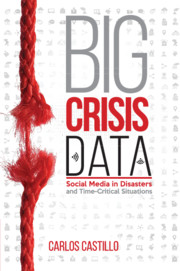Book contents
- Frontmatter
- Contents
- Preface
- Acknowledgments
- 1 Introduction
- 2 Volume: Data Acquisition, Storage, and Retrieval
- 3 Vagueness: Natural Language and Semantics
- 4 Variety: Classification and Clustering
- 5 Virality: Networks and Information Propagation
- 6 Velocity: Online Methods and Data Streams
- 7 Volunteers: Humanitarian Crowdsourcing
- 8 Veracity: Misinformation and Credibility
- 9 Validity: Biases and Pitfalls of Social Media Data
- 10 Visualization: Crisis Maps and Beyond
- 11 Values: Privacy and Ethics
- 12 Conclusions and Outlook
- Bibliography
- Index
- Terms and Acronyms
10 - Visualization: Crisis Maps and Beyond
Published online by Cambridge University Press: 05 July 2016
- Frontmatter
- Contents
- Preface
- Acknowledgments
- 1 Introduction
- 2 Volume: Data Acquisition, Storage, and Retrieval
- 3 Vagueness: Natural Language and Semantics
- 4 Variety: Classification and Clustering
- 5 Virality: Networks and Information Propagation
- 6 Velocity: Online Methods and Data Streams
- 7 Volunteers: Humanitarian Crowdsourcing
- 8 Veracity: Misinformation and Credibility
- 9 Validity: Biases and Pitfalls of Social Media Data
- 10 Visualization: Crisis Maps and Beyond
- 11 Values: Privacy and Ethics
- 12 Conclusions and Outlook
- Bibliography
- Index
- Terms and Acronyms
Summary
“What can speed humanitarian response to tsunami-ravaged coasts? Expose human rights atrocities? Launch helicopters to rescue earthquake victims? Outwit corrupt regimes? A map.” Patrick Meier's pioneering work in crisis mapping capitalizes on two key advantages of crisis maps: they act as a focus for digital volunteering efforts, and they provide information in a way that is familiar and easy to digest by relief agencies.
Previous chapters have described several methods for filtering, classifying, consolidating, and extracting trends from social media messages. A last but not least step of this process is to present this information in a way that is helpful to its intended users. Emergency managers often express the requirement to incorporate social media messages into a Geographical Information System (GIS), using a map-based display (Hiltz et al., 2014). Beyond maps, other visualizations have been used to highlight other aspects of the data, such as temporal trends, themes, topics, or connections.
This chapter describes current practices in the presentation of crisis data extracted from social media. It builds upon the various methods to process and consolidate social media messages presented in previous chapters. The emphasis is on crisis maps, which is probably the most popular paradigm used by volunteer communities and social media users to present information about disasters (§10.1). The chapter also analyzes other visual elements that are present in existing “dashboards” about social media during crises (§10.2), including their interactive elements (§10.3).
Crisis Maps
Figure 10.1 depicts various types of maps, which we describe on this section. The choice of which type of map to use depends on the requirements of end users. At a high level,we continue using the breakdown presented in Section 1.5 between user requirements seeking “actionable insights,” and user requirements capturing the “big picture.” This distinction can be used to select an appropriate type of map for a given application.
Actionable insights. End users interested in actionable insights would prefer representations in which information items are presented individually, or grouped in small clusters. This requirement can be satisfied using a dot distribution map, or a proportional symbol map.
- Type
- Chapter
- Information
- Big Crisis DataSocial Media in Disasters and Time-Critical Situations, pp. 138 - 151Publisher: Cambridge University PressPrint publication year: 2016



